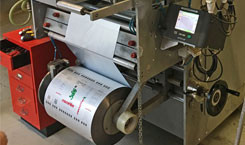Packaging coffee
The taste of coffee is uniquely aromatic and intense. To sustain all of its vitalizing characteristics alls the way from the roasting facility to the coffee cup, a variety of quite special packagings have been developed by coffee processing companies. Below, you can get an overview of the different packages and their assets and drawbacks.
The very first packaging
Normally, coffee beans aren’t roasted in their country of origin but rather have to go on a long journey before they reach their roasting facility. This is to avoid the loss of roasting aromas during shipping and also because a lot of the roasting expertise is located in Europe and other areas without their own coffee plantations.
The very first packaging of the raw coffee beans traditionally consists of characteristic gunny sacks made of jute or linen. Depending on the country, these sacks contain between 40 and 65 kg of raw coffee. The airy, permeable jute and linen ventilate the relatively moist, green beans during their long journey and prevent them from molding and rotting.
Some coffees are instead shipped in wooden barrels, especially Jamaican coffee is famous for this unusual tradition. Coffee from big farms that sell their coffee to large coffee corporations ship their beans als bulk goods in specially ventilated shipping containers.
Why is the packaging so essential?
During the roasting procedure, the raw coffee beans receive their unique character. Acids are reduced, sugar is caramelized and during the so-called Maillard-reaction, the beans get they brown color and up to one thousand different flavorings.
Many of these flavorings are very volatile. Especially the exposure to the oxygen in our atmosphere negatively influences the taste of coffee. Whole coffee beans, stored exposed to air, lose about 60% of their aromas in 4-6 weeks, ground coffee even more.
Moisture can have a detrimental impact on the flavor of coffee too. From a musty taste all the way to prober mould, moisture can ruin any coffee in no time
Freshly roasted coffee beans are outgassing for quite a while. This means that they are emitting so-called roasting gasses. If freshly roasted coffee is packed in an air-tight bag right away, this would eventually cause the bag to burst.
Valved packaging
A very common way to pack freshly roasted coffee ist the aroma-sealed packaging with a degassing valve. The beans are poured into bags made out of airtight materials like foil laminate, containing a special protective atmosphere.
This modified atmosphere prevents the coffee from reacting with oxygen while the degassing valve prevents the bag from swelling from emitted roasting gasses.
Vacuum packaging
Already ground filter coffee is generally packed in vacuumed bags. After degassing, the ground coffee beans are shrink wrapped in foil and the bags are mechanically deprived of air, preventing any further oxidation.
Compared to the valved packaging, this method offers the highest space-efficiency and is popular for storing and transporting coffee extensively, for example in army rations or for camping.
Packaging in tin cans
Coffee packed in cans is particularly handy for households. Because they’re super easy to reseal, coffee cans are a good choice for storing coffee beans or ground coffee.
You should always reseal the can as air-tight as possible and choose the right container size to minimize the amount of trapped air, the coffee could react with.
For the catering sector, coffee beans can be bought in cans, that directly connect to the top of a compatible coffee machine or coffee grinder. These cans are either vacuumed or filled with a modified atmosphere to protect the coffee from oxygen and moisture.
Packaging in capsules
Today, capsule systems are more popular than ever. Different systems and capsules are readily available, featuring many different ways or packaging and wrapping their coffee. Read more about capsule systems here.
The trend is going towards paper
Conventional foil, film and foil laminate for the packing of coffee contain aluminium. Because aluminium production requires excessive amounts of energy often harms the environment, some companies are now using a sustainable alternative. The new aroma-sealed packagings are made of paper and only use a moisture and air barrier layer made of recyclable and partly already recycled polyethylene plastics.

